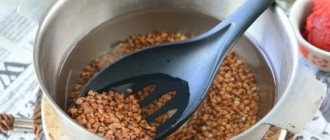How long does ready-made buckwheat last?
Usually cooked cereals are eaten immediately . It’s delicious, and moreover, vitamins, minerals, macro- and microelements are contained in greater quantities in fresh rather than in cooled and heated products.
Boiled buckwheat is stored:
- 1-2 hours at room temperature no more than +25°C;
- from three to seven days in the refrigerator at a temperature of +4°C;
- up to three days at a temperature of 0°C, up to seven days at a negative temperature on the balcony;
- 4 weeks at –18°C in the freezer.
Sometimes all storage conditions were met, but it was impossible to eat the cereal . If the porridge has spoiled, it is better to throw it away.
How to understand that you can’t eat buckwheat:
- unpleasant, sour or rancid, musty odor;
- liquid mucus at the bottom of the porridge container;
- mold: grains become whitish;
- bitter taste;
- presence of insects.
Interesting things on the site:
Is there fiber in buckwheat and how much is there in boiled cereal?
Comparison of which is healthier: buckwheat, lentils or oatmeal
What is the glycemic index of buckwheat?
Storing buckwheat
The older generation, having experienced the hardships of life, is unlikely to get rid of the habit of storing food for future use. Many people think that buckwheat is stored for a long time, so in order to avoid another price increase, they buy more of it. But that's not true. The shelf life of buckwheat, like other cereals, is limited.
In a closed package
Conventionally, buckwheat is stored for 2 years. Each variety of buckwheat product has its own shelf life:
- core – 15 months for the Far East, North Caucasus, Lower Volga region and 20 months for other regions;
- completed - 14 and 18 months, respectively.
Buckwheat retains its beneficial properties throughout its shelf life in full, provided:
- hermetically sealed packaging;
- dark, dry room;
- humidity not exceeding 70%;
- air temperature 25 degrees.
The expiration date of buckwheat can be found from the product labeling on the package. In addition, the manufacturer indicates the year and month the product was packaged. When making a purchase, check this information. The date stamped on the affixed label should alert you. After all, it is not known in what conditions the cereal was stored, and how much time passed before it was packaged.
When storing cereals beyond their expiration date, it is recommended to take a sample of porridge cooked from it at least once a month, thereby determining the possibility of its further use.
In open packaging and by weight
After opening the original packaging, the shelf life of the cereal is reduced several times:
- kernel – 4 months;
- completed - 3 months;
- green – 2 months.
Now it is impossible to make claims to the manufacturer about the spoilage of buckwheat. All responsibility for the safety of the product lies with the consumer.
How to store buckwheat at home:
- Remove the cereal from the store packaging and place it in glass, plastic, or metal containers intended for bulk products.
- To extend shelf life, dry the product in the oven or in a frying pan for 8-10 minutes at moderate temperature. Be careful not to overcook the grain, otherwise the nutrients will be destroyed. You can also use the freezer for processing, placing buckwheat there for a day.
- You can remove excess moisture from a container with cereal using kitchen salt. To do this, tie the salt in a piece of gauze and place it at the bottom of the jar.
- Slices of unpeeled garlic and 2-3 bay leaves will help repel insects. Dried lemon peel and chestnut fruits have the same properties. Just stuff them into the buckwheat container.
- There is another trick used to store grain at home. These are linen bags that need to be boiled in a saturated salt solution. Bugs do not grow in such bags, and the contents remain dry.
- It is recommended to find a dry place for containers with buckwheat, away from objects and products that emit strong odors. Otherwise, the cereal will absorb the aromas, and you will have to eat porridge that tastes like coffee, spices, or gasoline.
- There are no restrictions related to lighting in regulatory documents. But we must remember that direct sunlight not only illuminates, but also increases the temperature. The sun should be avoided.
We answer the question: is it possible to store buckwheat on the balcony in winter?
It is not advisable to store buckwheat on the balcony for the following reasons:
- temperature difference;
- humidity changes depending on the weather;
- sunlight has a negative effect.
How to properly store boiled buckwheat and rice
If cooked buckwheat or rice needs to be saved, then the porridge is put in the refrigerator. The temperature in it should be +4°C.
The rules for storing the cooked product are presented in the table.
| On water with salt | With milk | With added meat, butter, vegetables | |
| Buckwheat | 3-7 days | 24 hours | 3 days |
| Rice | 4 days | — | — |
The container where the product will be stored is important in proper storage . A glass jar or container with an airtight screw-on lid is the best option. They protect against foreign odors and do not absorb them themselves. After washing the glass, no pathogenic microorganisms remain on it.
Boiled cereals are also stored in plastic containers, but the shelf life will be shorter . Plastic containers are more often deformed and do not provide the necessary protection of products from foreign odors. As it is used, microcracks appear on the plastic, in which pathogenic microorganisms multiply. This causes the containers to smell unpleasant, and washing does not correct the situation.
Metal containers are the most unsuitable option for storage , as they quickly rust and cannot be hermetically sealed. Do not put the pan in which rice/buckwheat was cooked in the refrigerator. After a day, the product will develop a characteristic unpleasant aftertaste.
Attention! Plastic bags are not suitable for storing boiled cereal in the refrigerator. Condensation will form in them, which will spoil the product.
Before use, the amount of product that will be eaten is laid out from the container, the portion is heated, and the remainder is thrown away from the plate. It is not stored, since pathogenic microbes form in the remnants of heated food, even in the refrigerator, causing poisoning.
Rice and buckwheat absorb foreign odors well in the refrigerator . They are placed in a tightly closed container away from foods with a rich aroma.
Advice. Rice and buckwheat are completely compatible porridges. They are even boiled and eaten together - with chicken, meat gravy or vegetables.
Storage conditions for boiled buckwheat
There are general rules on how to properly observe the storage regime for this cereal. Clause 11 of GOST R 55290-2012 provides the values of air indicators in the rooms where cereals will be stored.
The temperature in the house or apartment should not exceed 25°C.
The maximum air humidity recommended by clause 11.5 of GOST R 55290-2012 is 70%. If the humidity is above 70%, then the cereal should be protected by placing it in another room.
Clause 7.3 of GOST lists the types of consumer packaging where it is permissible to place cereals when packaging them in production, which allows you to store the product in the following containers at home:
- paper bags;
- cardboard packs;
- bags made of food polymers (polyethylene, polypropylene, polyvinyl chloride).
The use of other containers is not prohibited - glass or plastic jars with lids (provided that the plastic is intended for food products).
The manufacturer also ships grains in canvas bags, so at home you can easily pour the grains into a fabric bag (if there are no rodents).
Clause 11.6 of GOST states that it is unacceptable to contain buckwheat along with goods that have a specific odor. For example, if there are cans of paint and cans of gasoline in the pantry or garage, then you should not keep cereal there - the product will become saturated with unpleasant odors.
On store shelves you can see buckwheat in different packages, different weights, prices and composition.
To extend the consumption of an open package of buckwheat over a longer period, you must follow the storage rules:
- light does not play a special role;
- You need to pour the cereal into plastic, paper, polymer, glass, cardboard containers.
If you choose polymer or plastic jars, they must be designed for storing food.
The shelf life of buckwheat is directly related to its original state
Therefore, when buying cereal, you need to pay attention to a number of important points.
- Packaging. It is better if it is vacuum and, of course, intact. Hermetically sealed kernels are stored for 15 to 20 months. Duration – 14-18 months.
- Date of filling and packing. Typically, this data is stamped on the seam of the package by the manufacturer. If information about the production time of a product is contained on a paper label pasted by the seller, there is no confidence in the reliability of the information.
- Presence of insects. Even factory-packed buckwheat sometimes gets moths and bugs. The likelihood of finding them in bulk products is even higher.
- Mold. If the grains are covered with a whitish coating and emit a characteristic musty smell, the buckwheat was stored in a humid environment and it has become moldy.
How long can boiled buckwheat be stored? This depends on the composition of the porridge and the place in which it will be located after cooking.
At room temperature, buckwheat cooked in water can remain fresh for 24 hours. Porridge cooked with the addition of meat, butter or milk - from 4 to 8 hours.
In the cold season, porridge (except milk) can be placed on the balcony. At sub-zero air temperatures, it will remain usable for three days.
Porridge should not be consumed if the following signs of spoilage appear:
- sour smell;
- slime at the bottom of the pan;
- green or black mold on the surface.
If there is still some cooked buckwheat left, and its shelf life is coming to an end, the freezer will help protect the product from spoilage. The porridge is placed in portions into plastic containers intended for freezing, sealed hermetically and sent to the freezer. The shelf life of frozen boiled buckwheat will increase to 2 weeks, but this will not have the best effect on its nutritional value.
Thus, storing raw and cooked buckwheat at home is easy. If you prepare the “correct” container, observe the temperature regime and periodically check the product for spoilage, its shelf life will be maximum.
Is it possible to store boiled buckwheat or rice on the balcony?
You can store buckwheat and rice on the balcony in winter and even autumn . It is not recommended to place a container of porridge on the balcony if the temperature there is above zero - for example, like in a refrigerator, +4°C. The humidity on the balcony is higher, and because of it, yellow/white spots appear on the cereal - a sign of spoilage.
The porridge is taken out to the balcony and stored at a temperature of 0°C for up to three days , at a negative temperature (up to –5°C) for up to seven days.
Important! The difficulty of storing rice/buckwheat on the balcony is that the temperature there can change dramatically. With such differences, the product will deteriorate.
What
It cannot be stored in the container in which the porridge was cooked . It is transferred to a glass container with a tight-fitting lid so that the porridge does not get airy.
If it is not possible to store the product in a glass container , take it out to the balcony in what is at hand. But the shelf life is 24 hours.
How to do it right
If you follow the rules, the product will be stored for the specified period.:
- sealed packaging;
- absence of direct sunlight that can heat the container with the product;
- absence of insects.
If frost hits and the porridge on the balcony is frozen , but at the same time it is fresh, it is heated in a convenient way and eaten.
Description of preparation:
I cook rice as a side dish only according to this recipe; no one wants to eat it without vegetables.
Frozen vegetables are very convenient, they cook quickly, you don’t need to peel or cut anything, and you always have them in the refrigerator. This is a must-have for me. The recipe for cooking rice with frozen vegetables is quite simple; the dish is prepared in one pan. I like to cook this way, but there is another option when the rice is pre-boiled and then added to the fried vegetables. This is possible, but my version is better. Try it! Purpose: For lunch / For dinner Main ingredient: Vegetables / Cereals / Rice Dish: Hot dishes / Side dishes
Is it possible to freeze cooked buckwheat and rice?
Freezing boiled porridge is one way to prepare food for future use . To store in the freezer, cook rice/buckwheat in water with added salt. The remaining ingredients are added after defrosting.
Is it possible to freeze boiled buckwheat and rice with meat, vegetables, mushrooms cooked in milk? This is possible, but this reduces the shelf life by half.
Porridges with meat, mushroom, and vegetable additives are frozen into portioned briquettes , which you take with you on hikes, fishing or hunting. They are heated over a fire.
Important! Thawed milk porridge is not given to children to prevent flatulence and poisoning.
In what container?
Boiled cereal is transferred in any volume into a plastic container with an airtight lid and a piece of paper with the date of freezing is glued.
Important! The lid of the container must fit tightly to the container, otherwise condensation will appear on the surface of the porridge, which will turn into ice and spoil the taste of the dish.
Porridge is also stored in the freezer in plastic bags . Place boiled buckwheat or rice in two bags at once. This way there will be no condensation and odors will not get inside. The taste and quality do not suffer.
For how long
Rice can be stored in the freezer for up to four months . At the same time, on the first day of freezing, take it out 2-3 times and shake it thoroughly. This will help you get a crumbly porridge when defrosting, rather than a sticky mass.
Buckwheat is placed in the freezer for a month . It is not recommended to store it any longer - the porridge will be tasteless after defrosting.
How to cook “Rice with frozen vegetables”
Prepare all the necessary ingredients.
Heat vegetable oil in a frying pan, add garlic. When the garlic begins to release its aroma, add the frozen vegetables to the pan. Fry for 10 minutes over medium heat until soft.
Add rice, salt and spices to the pan. Stir and fry the rice along with the vegetables for a few minutes.
By frying the rice with vegetables, the rice will remain soft but crumbly after cooking.
Pour the contents of the frying pan with broth, cover the frying pan with a lid and cook over low heat until the rice is cooked (15-20 minutes).
Rice with frozen vegetables is ready. The rice turned out very fluffy, with a bright taste, and the dish looked very appetizing! Have fun!
About soaking buckwheat (cooking in cold water)
Hello to all lovers of a healthy lifestyle! Today we are discussing the ideal way to prepare buckwheat - soaking it in cold water.
We recommend reading: How to Dry Homemade Pastille Better
Why ideal? Yes, because by preparing buckwheat this way you save health, energy and personal time. And the taste of the resulting buckwheat porridge is no different from the porridge that was cooked. Tested for yourself!
Delicious buckwheat porridge obtained by soaking in cold water
I knew the theory about preparing porridge by soaking (without using boiling or even hot water) for a long time; posts on this topic often appear on social networks. But somehow I never got around to trying it. I even do not know why…
And recently a regular reader wrote me a letter - my friend from Dnepropetrovsk Valentina Shilay (a skilled craftswoman and blogger, about whom I wrote in an article about the connection between creativity and happiness). And she shared her personal positive experience. Valentina's story prompted me to experiment and make a photo report for you.
Regular buckwheat and raw water. Everything is ready for soaking.
So, everything is ridiculously simple. Take a little buckwheat (preferably green, but I only had brown) and twice the amount of water. We combine everything in one vessel.
I prepared one serving (only for myself), because I was not sure whether my husband would like the porridge obtained without cooking. Looking ahead, I’ll say that in the end we “cooked” this buckwheat together: firstly, it turned out delicious, and secondly, I miscalculated a little and ended up with more than one serving.
Buckwheat is filled with cold water. The process has begun!
So. Fill the cereal with cold water (I use clean, unboiled water from a well). Cover with a lid (plate). So what do we do next? That's right, let's do other things!
After two to three hours, the cereal looks swollen and almost ready. There is still water in the bowl, but “readiness” is already close.
Three hours passed. Our “cold” porridge is close to ready.
I poured the water “by eye” without measuring, so I miscalculated a little. When, after a couple of hours of tasting it, I realized that the buckwheat was ready, I simply drained off the excess. It turned out to be a delicious porridge. Try it!
Another two hours passed. You can eat!
Finally, a few more points.
- Porridge, as well as any other dishes prepared from natural, living raw materials without heat treatment, are not only healthy food for humans, but also a kind of medicine. They heal and rejuvenate the body. In this light, green (unroasted) buckwheat can be considered a good starting material. Brown (fried) - not the same...










